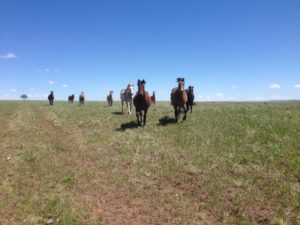Over the past week I’ve had a few moments of horse training awareness where I gained a new perspective on my past experiences and the training tools in my toolbox. One of those is a semi-controversial technique known as “bitting up.” Years ago, “bitting up” was often used to introduce the young horse to a bit. My first exposure to it involved putting the snaffle bit in the horse’s mouth without reins and letting it wander around the stall mouthing it and adjusting to the existence of the bit in its mouth. The three horses who got their first bits at my hands started that way. I also used this technique to introduce my first Quarter Horse, Sparkle, to her curb bit.
Then I started out with G, and learned a bit more about how to use bitting up in part as a means to introduce the horse to carrying the bit and develop a headset. In this mode, still using a snaffle, you tied the reins to the saddle, leaving enough play in the reins so that the horse’s nose was two or three inches in front of the vertical. Then you turned the horse in a pen and let it wander around, playing with the bit and getting comfortable with picking up contact without the interference of a rider. At this point, the horse was learning about giving to the pressure of a bit on its own. The key was that a.) the horse was unrestrained except for that bit contact and b.) the horse was under supervision. This didn’t go on for very long, perhaps 5-10 minutes max. Then, depending on where the horse was in training, you climbed on and did a short ride.
As the horse’s training advanced, then you tightened the reins slightly, still allowing for the nose to be ahead of the vertical. At this point, the horse was worked on a lunge line or in a round pen, working on balance and contact. The key was that the horse learned on its own about yielding to bit pressure without the vagaries of human hands. The idea was that the horse taught itself about bit pressure.
Hold that thought. It becomes important later on here.
One of the things that G said about this type of bitting up was that it not only helped the horse learn on its own, but that it created a habit of discipline. We did this sort of work not only with green horses but horses going through retraining. Horses who lacked respect for the bit. Horses whose mouths were desensitized by heavy-handed riders.
The technique, of course, is one that gets misused. One of the worst versions of it was revealed a few years ago when a trainer in Southern California used it with a curb bit, and tied the reins so tight that the horse threw herself and broke her neck. Unsupervised, to boot. A curb bit is a leverage device, operating not just on the bars of the horse’s mouth (a toothless gum section between incisors and molars) but on the jaw, possibly the roof of the mouth (depending on how high the curved section of the bit is), and on the horse’s poll (a very sensitive area behind the ears). Too much pressure in these places can cause a horse to rear and flip…which is apparently what happened in that case.
But there are other versions of misuse. Using it with the nose cranked to the chest. Doing it for hours on end. Doing it with a thin twisted wire bit. Probably many other variations I don’t really want to think about.
Over the years, I discovered that this tool had other uses. When young Mocha was sparky, I’d bit her up and put her on a lunge line or the round pen. A short period–5-10 minutes, max–and she would switch over from being Ms I Know Everything to Ms Okay I’ll Listen. I started pulling this tool out in the springtime even as she matured and became more steady.
This past week it all came together. She’s out in Big Pasture now, hilly on the end of a long ridge flat, running with the herd. The first day I rode her, she was total Miss Butthead. Nickering at the herd, her attention on the herd, wanting to run and not pay attention to the rider on her back, even with the curb bit in her mouth and some schooling.
(an example of the herd and Big Pasture)
Well, that wasn’t gonna work. So the next time, I brought out the snaffle and the lunge line, and bitted her up. Then we reviewed the concept of listening to the human instead of wondering what the herd was doing, including screaming for them. And whoa. Especially whoa, because she hadn’t been particularly listening to that.
5 minutes later, we had brains reinstalled.
A revisit on the next ride also ensured that Brains Were Installed. Both times we had a pleasant ride, including a stretch of gallop along a flat section of jeep track. Little mare started dancing as we swung around to the starting place, took off as fast as she could once I kissed to her and leaned forward, and–best of all–she eased off and stopped when asked. And our canters away from that stretch of flat, safe place for hard gallop were controlled and quiet. Oh, a couple of times she asked to run, and I said no. But the key was–she listened.
When I go back and look at previous year’s entries (I was looking for a picture that isn’t on this computer), I see many notes about having to do just that at G’s place, at around this time of year. So it’s a normal thing, just a phase of late spring or early summer.
And damn, I’m sure glad I’ve got this tool in my bag of training tricks.

